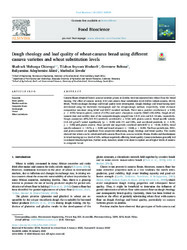| dc.contributor.author | Chisenga, Shadrack Mubanga | |
| dc.contributor.author | Workneh, Tilahun Seyoum | |
| dc.contributor.author | Bultosa, Geremew | |
| dc.contributor.author | Alimi, Buliyaminu Adegbemiro | |
| dc.contributor.author | Siwela, Muthulisi | |
| dc.date.accessioned | 2022-05-27T13:02:26Z | |
| dc.date.available | 2022-05-27T13:02:26Z | |
| dc.date.issued | 2020-04 | |
| dc.identifier.citation | Chisenga, S. M., Workneh, T. S., Bultosa, G., Alimi, B. A., & Siwela, M. (2020). Dough rheology and loaf quality of wheat-cassava bread using different cassava varieties and wheat substitution levels. Food Bioscience, 34, 100529. | en_US |
| dc.identifier.issn | 2212-4292 | |
| dc.identifier.uri | https://doi.org/10.1016/j.fbio.2020.100529 | |
| dc.identifier.uri | https://www.journals.elsevier.com/food-bioscience | |
| dc.identifier.uri | https://hdl.handle.net/13049/472 | |
| dc.description | The article was published under the CC BY-NC-ND 4.0 license. | en_US |
| dc.description.abstract | Cassava flours obtained from 6 cassava varieties grown in Zambia were incorporated into wheat flour for bread making. The effect of cassava variety (CV) and cassava flour substitution level (CFSL) (wheat:cassava, 90:10, 80:20, 70:30) on dough rheology and bread quality were investigated. Dough rheology and bread baking were determined using the Brabender Farinograph and the straight-dough method, respectively, while chemical composition was done using AOAC and AACC standard methods. There was a positive correlation (r = 0.60, p < 0.05) between gluten content (7–13%) and water absorption capacity (WAC) (60–62%). Dough development time and stability time of the composite doughs ranged from 1.5-11 min and 6.3–12 min, respectively. Dough consistency (476–512 FU) positively correlated (r = 0.54) with gluten content. Bread specific volume (1.5–2.5 g/cm3) varied significantly (p < 0.05) with CV and CFSL, and correlated positively (r = 0.76, p < 0.05) with gluten content. Flour particle size negatively correlated with WAC (r = −0.26, 0.001), bread specific volume (r = −0.72, p < 0.05) and bread volume (r = −0.68, p < 0.05). The flour particle size, WAC, and gluten content are significant flour properties influencing dough rheology and bread quality. The results showed that wheat can be substituted with cassava flour from cassava varieties Mweru, Kariba and Katobamputa in bread making up to a level of 10%, without negatively affecting bread quality. Cassava inclusion generally led to reduced bread weight loss. Further work, however, needs to be done to explore use of higher levels of cassava in composite bread. | en_US |
| dc.language.iso | en | en_US |
| dc.publisher | Elsevier | en_US |
| dc.relation.ispartofseries | Food Bioscience;34, 100529 | |
| dc.subject | Bread quality | en_US |
| dc.subject | Manihot esculenta | en_US |
| dc.subject | Composite flours | en_US |
| dc.subject | Farinograph | en_US |
| dc.subject | Gluten | en_US |
| dc.subject | Wheat substitutes | en_US |
| dc.title | Dough rheology and loaf quality of wheat-cassava bread using different cassava varieties and wheat substitution levels. | en_US |
| dc.type | Article | en_US |

